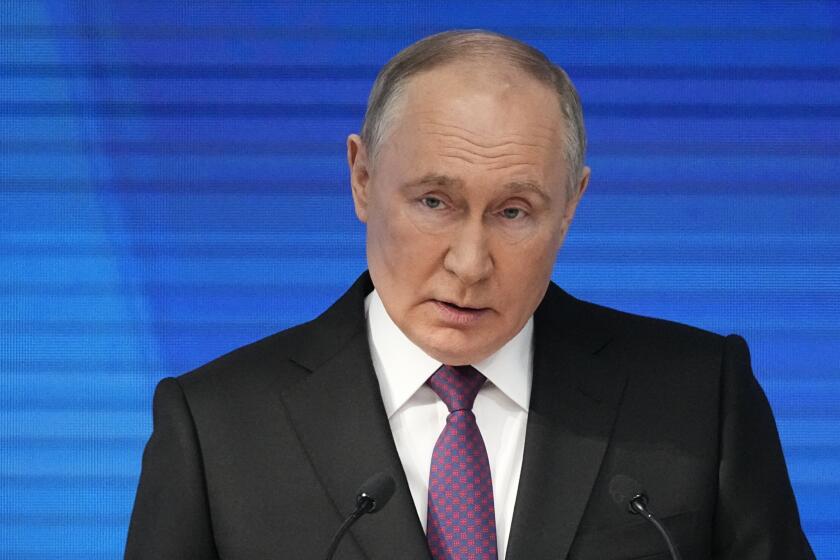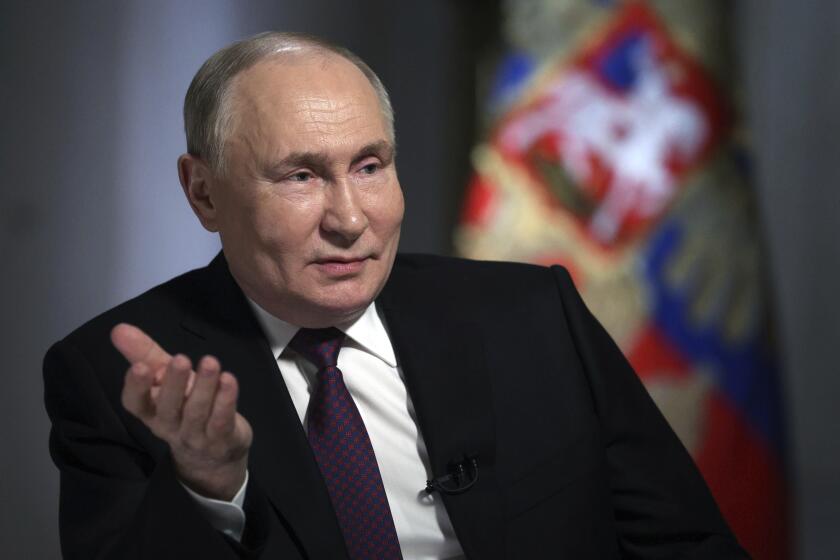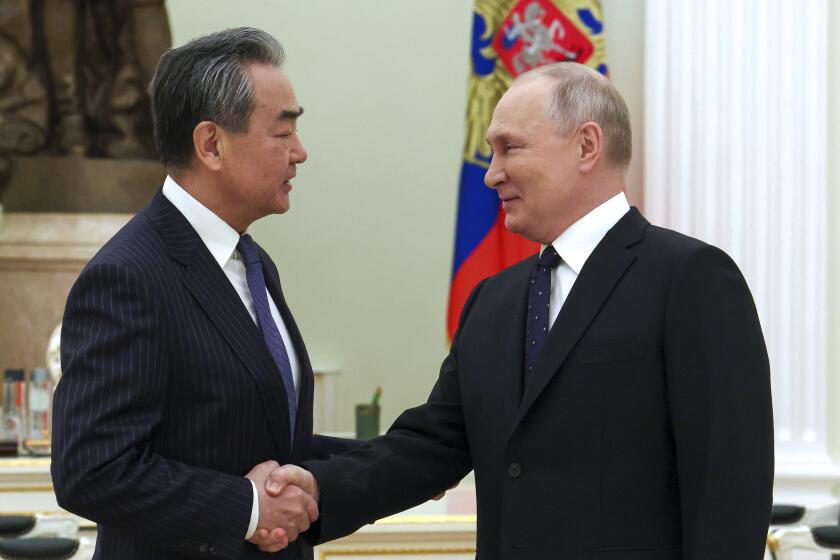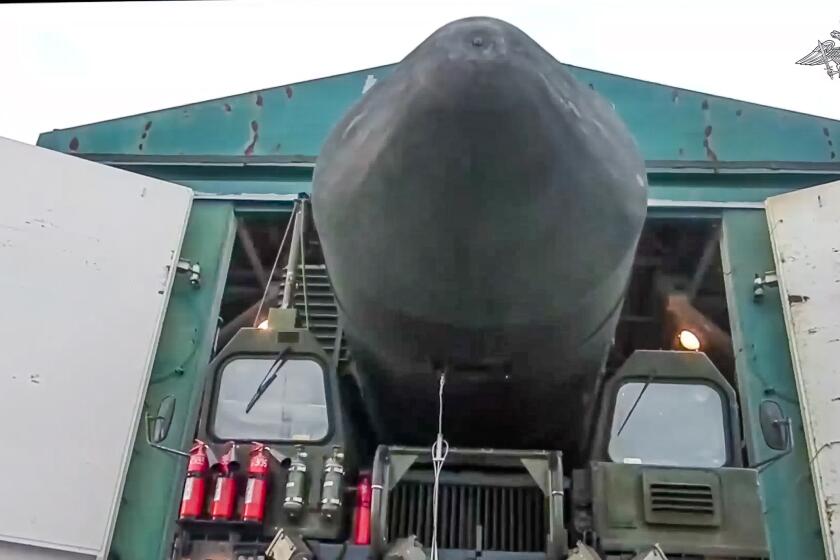News analysis: Why Putin is raising the specter of nuclear weapons again
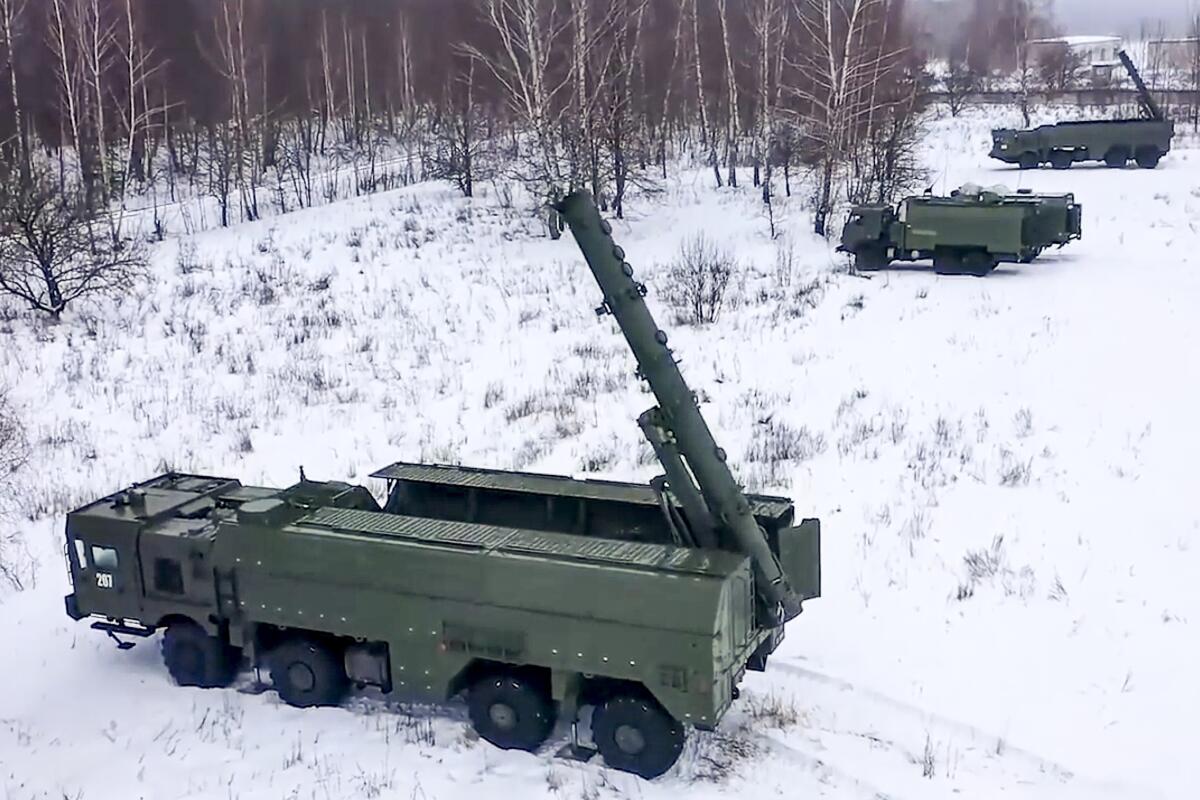
WASHINGTON — Once again, Russian President Vladimir Putin is seemingly rattling the nuclear saber. But why now?
The Kremlin, citing recent comments by Western leaders regarding the war in Ukraine, said Monday that it would soon carry out simulated use of battlefield, or tactical, nuclear weapons — marking the first time Moscow announced such an exercise.
The announcement drew a sharp response. U.S. Defense Department spokesman Maj. Gen. Patrick Ryder called it “entirely inappropriate.” NATO spokesperson Farah Dakhlallah termed Moscow’s plans “dangerous and irresponsible,” and the European Union called on Russia to “stop the escalation.”
Like so many pronouncements from Moscow, this one’s timing might matter as much as its substance.
This week holds two red-letter days for Putin: his inauguration on Tuesday to yet another presidential term after an unsurprising landslide election win in March, coupled with Thursday’s traditionally bombastic Victory Day celebrations commemorating the Soviet victory over the Nazis.
Russian President Vladimir Putin has vowed to fulfill Moscow’s goals in Ukraine and sternly warned the West against a deeper involvement in the fighting.
It is commonplace for nuclear powers such as Russia — or the United States, for that matter — to conduct checks of their weapons stockpiles. But declaring an explicit connection between exercises involving practice use of nuclear weapons and comments by adversarial governments about an ongoing conflict is an unusual diplomatic move.
Russia’s Defense Ministry said the planned tactical nuclear drills near Ukraine were intended to “unconditionally ensure the territorial integrity and sovereignty of the Russian state.”
Tactical nuclear weapons, as the term implies, are far smaller and less powerful than strategic nuclear armaments such as intercontinental ballistic missiles carrying nuclear payloads that could lay waste to large population centers. But nuclear threats, even veiled ones, have a way of grabbing everyone’s attention.
Unlike strategic nuclear weapons, battlefield nuclear munitions — which are relatively compact and easily transportable — are not subject to international arms agreements, and Russia’s stockpiles are shrouded in secrecy. Such weapons can be deployed in the form of air-dropped bombs or short-range missiles.
In a preelection interview, President Vladimir Putin says Russia is ready to use nuclear weapons if its sovereignty or independence is threatened.
The Pentagon closely monitors Russia’s nuclear posture, and over the course of the Ukraine war, the Biden administration has reported no changes — even at times when Russian rhetoric suggests heightened tensions.
Western analysts say the latest comments typify a pattern that has taken hold since Putin’s February 2022 full-scale invasion of Ukraine — that is, any perceived Western escalation is met with Kremlin threats of a nuclear nature, meant to raise the specter of all-out war between Russia and the U.S.-led coalition aiding Ukraine.
Among observers of this conflict, there’s some difference of opinion as to whether these warnings are any more worrisome or significant than similar ones in the past — though many dismissed Monday’s announcement as little more than bluster.
Alexander Clarkson, a European studies lecturer at King’s College in London, suggested that the development did not reflect some carefully calibrated policy messaging by Moscow. Russia’s threshold for use of nuclear weapons, he wrote on the social platform X, is “whatever Putin and a small inner circle of defense apparatchiks think it is when getting out of bed in the morning.”
Putin alarmed the world as he announced Russia was leaving New START, the last major nuclear-control treaty. He wants to send a threatening message.
However, the Kremlin announcement could give fresh ammunition to opponents of further Western aid to Ukraine. During a drawn-out congressional blockade of military assistance — finally resolved with approval last month of $61 billion in aid for Ukraine — far-right Republicans accused the Biden administration and Ukraine’s other Western partners of playing with nuclear fire by continuing to support the government of Ukrainian President Volodymyr Zelensky.
Ukraine was dismissive of the Russian announcement, saying it is part of a familiar playbook.
“We do not see anything new here,” Andriy Yusov, a Ukrainian military intelligence spokesman, said on national television. “Nuclear blackmail is a constant practice of Putin’s regime.”
A senior Russian diplomat says Moscow has suspended sharing information about its nuclear forces with the U.S., including notices about missile tests.
The latest rhetorical flare-up over nuclear weapons comes at a time when Ukraine is undeniably struggling on the battlefield.
A much-vaunted Ukrainian counteroffensive foundered in the summer. Now, as the weather improves, some of the country’s allies — and even some Ukrainian defense officials — have voiced concerns about whether Russian forces might exploit weakness in Ukrainian fortifications and break through somewhere along the front lines.
The eastern Ukrainian town of Chasiv Yar is considered vulnerable to a Russian onslaught, although it sits on high ground, a position that is usually favorable to the defenders.
For the last several months, Russia has been rattled by a campaign of strikes within its border by Ukrainian forces. The United States has largely enjoined Ukraine to not use American-provided weaponry for such attacks, mainly aimed at Russian energy infrastructure. But close allies such as Britain are not placing similar constraints on Ukrainian forces.
On Monday, Britain’s ambassador to Moscow, Nigel Casey, was summoned to the Russian Foreign Ministry for a formal protest after David Cameron, the former British prime minister who is now the foreign secretary, declared last week that Ukraine had the right to use British armaments to launch strikes inside Russia.
Cameron, who visited the Ukrainian capital last week, said then that Ukraine could decide how to use British-provided long-range weapons, not ruling out strikes on Russian territory. Moscow calls that an abrogation of previous British assurances to the contrary.
Even more irksome to Russia than the Cameron comments were recent remarks by French President Emmanuel Macron, who publicly mused about the idea of sending European troops to Ukraine.
Kremlin spokesman Dmitry Peskov called the British and French statements about such potential deployments “unprecedented” and a “completely new round of escalation of tension.”
Asked Monday about reasons behind the tactical-nuclear-weapons exercise, he pointed in particular to Macron’s remarks.
At the same time, Russia is characterizing its own sharply stepped-up production of conventional weapons such as artillery as necessary in light of actions by Ukraine’s allies.
“We are now at the stage of open confrontation, which I hope will not result in a direct armed conflict,” a senior Russian envoy, Ambassador-at-Large Grigory Mashkov, told the state news agency RIA.
He said Moscow would take steps to strengthen its defense capabilities, including bolstering missile stockpiles, “in order to discourage any potential enemy from testing Russia’s strength.”
In recent days, Russia has also railed against North Atlantic Treaty Organization military exercises near its frontiers.
Over the weekend, Foreign Ministry spokesman Maria Zakharova described the months-long maneuvers, set to run through this month, as a clear signal that the alliance is setting the stage for conflict with Russia. The drills, involving about 90,000 troops, represent NATO’s biggest such exercise since the Cold War.
More to Read
Sign up for Essential California
The most important California stories and recommendations in your inbox every morning.
You may occasionally receive promotional content from the Los Angeles Times.
